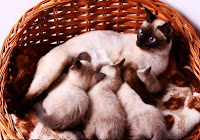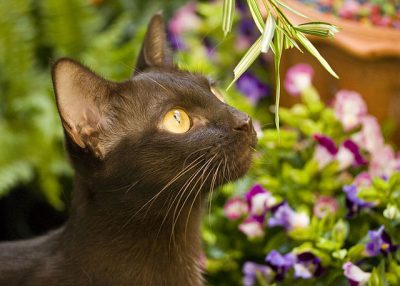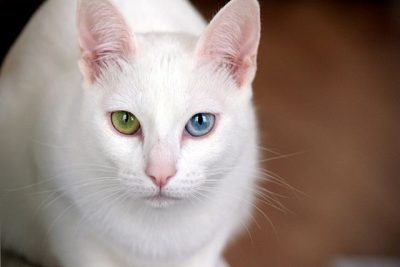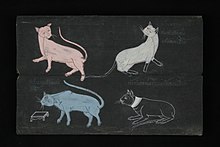Thailand brought the world the Siamese cat a long time ago, when the country still went by the name of Siam. This cat has become a world favorite. Though times have changed, the Siamese does not represent the only Thailand cat breed, though still the best-known.
At one time, there lived 23 separate breeds of cats native to Thailand. Now 18 of these breeds have gone extinct, and 5 remain. These, fighting for survival, are regarded as national treasures now. Dedicated cat-lovers are slowly bringing back these five breeds from the edge of oblivion.
One source of information about these earlier cats is the Tamra Maew a book of cat poems written by Buddhist monks more than 300 years ago. The featured image shows a page from this book. According to the book, several among the 23 breeds brought good luck, and several others offered bad omens.
Siamese Cat Background
This cat has the honor of being one of the first distinctly recognized breeds of Asian cats. The original Siamese became one of Europe and North America’s most popular breeds in the 19th century. Now a modern-style Siamese has emerged.

Though the coloration remains the same, the modern variety has blue almond-shaped eyes, a triangular head shape, large ears, an elongated, slender, and muscular body, and a variety of point coloration. This modern Siamese carries little resemblance to the original.
The “old-style” Siamese had a much rounder head and body. Now this style of cat has been re-established in Thailand and is known as the “Thai cat.” Both old-style and modern Siamese may be found among the foundation stock for several other breeds, developed by crossbreeding.
Surviving Breeds A National Treasure
Cats receive much admiration and praise from enthusiasts in Thailand. In modern-day Thailand, 33% of the Thai population owns cats. Now, as the population learns more about these breeds on the edge of extinction, more cat advocates are stepping up to help with the battle.
The International Maew Boran Association (TIMBA) became created, dedicated to preserving Thailand’s five ancient cat breeds. These include the Suphalak, the Wichienmaat, The Korat, the Khoa Manee, and the Konja. A brief description of these breeds follows.
The Suphalak Cat
This lovely cat claims a place as a common house cat in Thailand. Small and short-haired, the cat has an evenly pigmented rich red-brown coat in various shades of dark brown. The cat has yellow-gold eyes. The noses are brown while paws carry pink undertones. However, pure-bred cats from this strain are uncommon.

At present the current breeding population includes only two males and three breeding females. One of the males, named Samsen, now retired from breeding, belonged to breeder Kamnan Preecha, who has dedicated his life to preserving the Suphalak breed,
Now TIMBA works to preserve the breed. They are being selectively outcrossed with the Korat, Thai Burmese, and Konja to rescue this cat from extinction.
The Wichienmaat Cat
This cat, more commonly known as the Thai cat, is the original of the breed. Now, the modern Siamese has a different appearance, with its sleek body shape. The Thai cat, with a rounder face, body, and eyes, began in Buddhist temples, and once received their care from Thai royalty.

The name “Wichienmaat” means “moon diamond.” Believed to be extremely valuable, when the Burmese army invaded Siam in 1765, they saw this cat as more valuable than gold. They believed that those who owned such a cat would be wealthy.
The first of these cats to reach the United States arrived in 1878 as a gift to the wife of then President Rutherford B. Hayes. Now the cat has become foundation stock for many different breeds, and is considered one of the original pedigreed cat breeds.
The Korat Cat

This cat comes from the Korat region of Thailand. The coat color is a smoky grey or silver-coated. The ears appear prominently pointed, with a bright-green eye color. The Thais consider them a symbol of good luck, fertility, and abundant harvest.
Therefore, one did not buy this cat, but presented a pair of them as a gift to newlyweds. The cats then served as a symbol of a long and fortunate marriage.
This beautiful cat now has become relatively rare in Thailand. Its value includes a heightened sense of hearing, sight, and smell. The cat has a rather bossy demeanor.
The Khao Manee Cat
This cat’s special claim to fame comes from its odd-colored eyes. The eyes are yellow, blue, or odd-colored. Referred to as the “white jewel” of the Maew Boran, the cat also receives the title of the “Diamond Eye cat.” It has a solid white coat. It has pink paw pads, inner ears, and nose.
The cat is especially admired for its elegance and its friendly nature. This animal has become associated with good luck, and began as a royal cat. In the 19th century, households believed that possessing such a cat would bring them “long life and title.”

Now, Thai and non-Thai breeders work together to preserve this breed. At one time the cat stayed within the royal palace, and remained protected there for generations. This cat’s first breeding outside Thailand occurred in 1999. The cat remained exclusive to Thailand for more than 650 years prior to this time.
The Konja Cat
The only breeder continuing to attempt preservation of the Konja cat is Kamnan Preecha. The cat, a gleaming black, still has a presence in almost every monastery in Thailand. A belief continues that feeding the cat will bring you good fortune.
This cat has the appearance of a miniature panther, with its gleaming black fur and yellow eyes. Typically, its coat of only black can cause it to be mistaken for a Bombay cat.
Since I could not find a picture of the Konja cat, will include a video of “Cats of Thailand” instead.
Thailand has a phenomenal number of stray cats. Organizations as well as monasteries work to feed all these animals. In that country, a monastery will never turn away a stray cat. As more and more Thai nationals become interested in cats, perhaps they will also help to decrease this number.
References used for this post
ling-app.com/th/thai-cats/ http://en.wikipedia.org/wiki/Siamese_cat#History theculturetrip.com/asia/thailand/articles/the-most-beautiful-cat-breeds-from-thailand/ moremeows.com/are-cats-popular-in-thailand-fantastic-cat-info/


Very interesting article about breeds of cat’s I’ve never heard of. Thanks for sharing this information.
Oh, good! It’s always nice to know I’ve sent new information. Glad you found the article interesting, and thanks for commenting, Elaine.